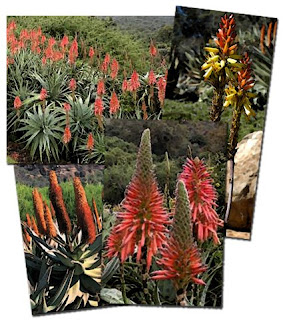
Many of Southern Africa’s Aloe species are about to bloom, attracting bees, butterflies and a vast array of garden birds. Enjoy the spectacle.
Barbara Jeppe described 139 species of Aloe in ‘Aloes of South Africa”. There are aloes flowering somewhere in the region throughout the year. The peak months are June, July and August, the bleakest and driest months for most of southern Africa. In these months the countryside comes alive with thousands of red, orange and yellow blooms of many aloe species, thereby ensuring survival for many bird species.
The larger aloes may have trunks that are partially or fully clothed in old dry leaves. Others are bare and branched like Aloe bainsii, growing to 15m or more in height. The trunk is beautifully striated. The tree aloe makes a handsome garden feature. Aloe arborescens is a dense, many branched shrub aloe. In the Transkei Region of the Eastern Cape province, this aloe has been used to create kraal fence, dense and impenetrable, and an excellent windbreak.
Aloe thraskii is the dune aloe found in KwaZulu-Natal’s dense dune forests, often close to the pounding surf. It is very easy to propagate for seaside homes. Aloe ferox (red aloe) is considered to be a very heavy producer of nectar. An Eastern Cape ornithologist recorded the following bird species visiting Aloe ferox —various sunbirds, black-headed orioles, fork-tailed drongos, weaver birds, pied starlings and speckled colies. In KwaZulu, Aloe marlothii has been known to attract doves, various tinkers, flycatchers, glossy starlings, canaries, warblers, crombecs, scimitar billed wood hoopoes, babblers, scrub robin, black tit, penduline tit, white-necked raven and yellow throated sparrow.
Aloe candelabrum is a showy aloe in the KwaZulu-Natal midlands. Most of the smaller aloes are stemless and carry less nectar, however, they may be better suited to smaller gardens. Aloe saponaria, A. chabaudii, and A. pluridens come to mind, the last growing under shade conditions in coastal bush. A. cooperii, a summer-flowering grass aloe, grows taller under damp conditions. Aloe wickensii, a native of Limpopo Province is possibly one of the most beautiful, which in full bloom appears bi-coloured, the many branched flower spikes like yellow-topped red pyramids.
Many aloe species tolerate a wide range of habitats. Propagation is easy but conditions for their native area should be simulated as much as possible. Grow them from truncheon, cuttings or seed. A branch of A. bainsii, thrust into the ground in situ will take root quickly.
TAKE NOTE
Aloes are protected species and may not be collected from the veld, or sold, without a permit. Offenders face severe fines.
The South African National Biodiversity Institute (SANBI) sells seed and publishes a seed catalogue on its website http://www.sanbi.org. For photos and cultivation information on hundreds of aloes and other indigenous plants, go to SANBI’s plant information website www.PlantZAfrica.com.






